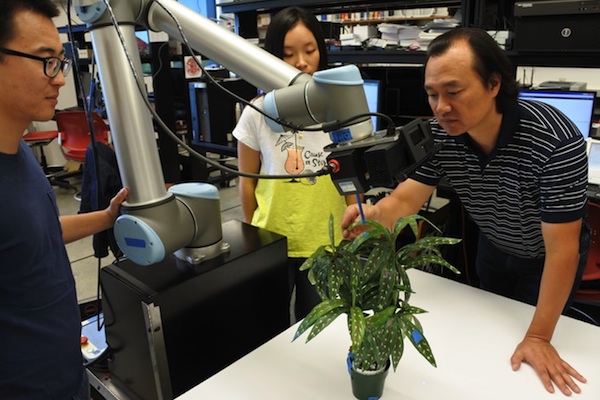
Creating New Worlds to Study Plant Life
The name could be from Star Trek. “Step into the Enviratron,” Mr. Spock might say, “and be transported to the environment of your choosing.”
In a way, that’s how it will work— for plants.
It’s a concept that’s never been done before. Scientists and technicians are still putting the pieces together for a series of plant growth chambers located in a building at Iowa State’s Agricultural Engineering Agronomy Farm.
Steve Whitham, a professor of plant pathology and microbiology, is co-leading the project that will automate phenotyping. In this instance, phenotyping is measuring plant characteristics that might be of interest biologically or from a production standpoint—for example the shape of a plant, its response to temperature and other variables.
There are other automated phenotyping facilities around the world, but the plants are grown in one area, then moved to the instruments that take the measurements. That arrangement has a couple of disadvantages: the plants are likely grown under similar conditions, and the movement could be considered an experimental treatment.
“With the Enviratron, we have eight growth chambers, and you could set each one with a different set of environmental conditions—vary light, carbon dioxide, humidity, water or nutrients,” he says. “So in one experiment I could have eight different environmental conditions running at once. The other aspect is we have the rover that moves between chambers instead of the plants coming to the instruments. Plants stay in the chamber eliminating the movement treatment and minimizing environmental fluctuations.” The design of the growth chambers is one of many challenges involved in the facility. Percival Scientific in Perry, Iowa, is developing the one-of-a-kind chambers.
The project is one of the multi- disciplinary efforts for which Iowa State is known. Each of the co-principle investigators serve unique roles: Steve Howell, distinguished professor in genetics, development and cell biology, is the project manager; Carolyn Lawrence- Dill, genetics, development and cell biology associate professor (see page 12), is in charge of data management; and Thomas Lubberstedt, agronomy professor, is on the management team.
One of the main challenges is the robotic rover, which is being designed by a team led by co-principle investigator Lie Tang, an associate professor of agricultural and biosystems engineering.
“You can observe and measure phenotype, but it has been mostly done manually,” Tang says. “We see more and more automated applications to help scientists collect data. With the Enviratron we can probe the plant with very high precision using the robotic arm’s advanced imaging and sensors.”
Designing the one-of-a-kind robotic rover involves both hardware and software, requiring a team with backgrounds in computer, electrical and agricultural engineering, computer sciences and the plant sciences.
“Part of the challenge is that biological objects are so complex, they grow and develop so your robot needs to be able to adapt,” he says.
The project is being funded by a three-year National Science Foundation grant.
Perhaps as early as next year, what sounds like science fiction could be providing breakthroughs for Iowa State University researchers.



